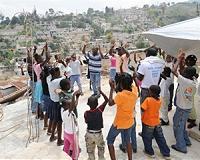| . |  |
. |
Leogane, Haiti (AFP) Jan 9, 2011 When Haiti's earthquake swallowed the living, it also tore through graveyards, spitting out the dead, and, a year later, those dead, much like the living, know no peace. At the town cemetery in Leogane, epicenter of the January 12, 2010 quake that killed nearly a quarter million Haitians, weathered bones point accusingly from smashed tombs at the sky. The graveyard, a necropolis of family mausoleums, is every bit as ruined as Leogane itself, where the living cling on without electricity, clean tap water, or much hope. Everywhere in the cemetery, blue and turquoise tombs in a riot of styles lie toppled, their sides missing, their inhabitants gone or still there, but lost in the mud and fragments of clothing. A broken skull here, a shoe there. Ribs poke from pink-blossoming weeds. On a narrow path, an upturned wooden casket. Inside some of these defiled houses, the round-ended white coffins that are popular in Haiti sit in plain view, open to the rain, sun, wind and a world they were never meant to see again. Other tombs lie startlingly empty, their mud floors cracked by the heat of sun that had supposedly been banished forever. A faded sign over the cemetery's iron main gate lists opening hours, noting that visits on Saturdays and Sundays are by appointment. But there are no rules in Haiti today. Inside, a gaunt, long-horned cow munches in the crooked shade of a mausoleum inscribed "Famille Eliangene Ulysse." Across the way, a hound appears, snarling, from a ruined tomb. Perhaps if these dead could speak, they would say much the same as the living. Leogane, the point from which the seven magnitude quake ripped out across the most populated corner of Haiti, is a town deprived of its heart. Almost nothing has been reconstructed. Police sit in tents on the site of their old station. The bank door says "open," but the cracked building is closed forever. A blank patch marks where they removed the rubble of a school. Catholics pray on the tiled floor of their old church, all -- along with the altar -- that survived. "Total despair," says church volunteer Antoine Laguerre, sweeping the floor. He lost his house a year ago and moved with his four children into a tent. They're still there. Laguerre, 44, begins to describe the moment when the quake, known by Haitians as Goudu-Goudu, struck. But the words don't come. "We keep praying," he says. His eyes well up. Goudu-Goudu killed thousands in Leogane, where locals point to a sinister, deep fissure splitting the main road as marking the eye of the catastrophe. Some 2,000 of those dead lie in two mass graves outside the broken cemetery. American volunteers are tidying the area and building a memorial. "As we complete the work, it comes closer to the sacred," said the architect, Nathaniel Harrold, 35. "When we came here, it was the profane. It was a barren patch where people were literally pissing over the (resting place) of 2,000 people." Inside the cemetery, Pierre Saint Louis is also trying to lay ghosts to rest. The 74-year-old man has hired a gravedigger to reconstruct his father's broken grave. Standing in the ferocious Caribbean sun he watches the gravedigger, shirtless, pick away at the rectangular hole. "I'm not happy and the dead are not happy," Saint Louis says. "I'm helping the dead." Will the living ever get the help they need? The gravedigger, Jean Luis Quesnel, shakes his head. Then he reconsiders. "God sees everything, so I think that one day or other Haiti will change."
Share This Article With Planet Earth
Related Links Bringing Order To A World Of Disasters A world of storm and tempest When the Earth Quakes
 Haitians turn to God at quake anniversary
Haitians turn to God at quake anniversaryPort-Au-Prince (AFP) Jan 9, 2011 Faith is about all Haitians have left a year after an earthquake destroyed their country and on the last Sunday before the anguished anniversary, they flocked to praise God. In Port-au-Prince, hundreds of Roman Catholics attended Mass under tents erected next to the cavernous ruins of the Cathedral of Our Lady of the Assumption. Their prayers filtered through palm trees and over rubble. ... read more |
|
| The content herein, unless otherwise known to be public domain, are Copyright 1995-2010 - SpaceDaily. AFP and UPI Wire Stories are copyright Agence France-Presse and United Press International. ESA Portal Reports are copyright European Space Agency. All NASA sourced material is public domain. Additional copyrights may apply in whole or part to other bona fide parties. Advertising does not imply endorsement,agreement or approval of any opinions, statements or information provided by SpaceDaily on any Web page published or hosted by SpaceDaily. Privacy Statement |